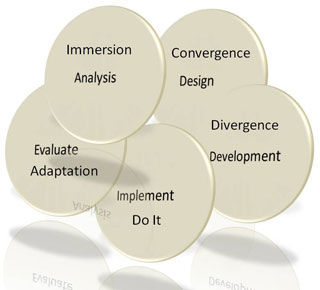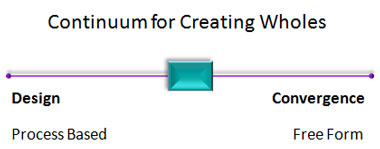This is the third post of a series on extending ADDIE in order to solve wicked or complex problems:
- Post 1: Innovating With ADDIE
- Post 2: Immersion and Analysis

In the last post I discussed using a mixture of Analysis and Immersion in order to gain insight and understand the shape of the problem. The next step in Frog Design's framework for solving problems is Convergence — the bringing together of everything you learned in the first step in order to integrate things together; or in other words — to create a whole.
Now this is basically what you do with the Design phase of ADDIE, except with ADDIE, it implies a set of steps, such as developing learning objectives, identify the learning steps, developing tests, etc. If we look at the two terms being placed on a continuum it would look like this:

Unlike the Immersion and Analysis Continuum in which the complexity of the environment determines where you would be placed on the scale, the goal here is to aim towards the middle. That is, if you follow the design process too closely, then you might be turning it into a process model as discussed in the ADDIE Timeline that may take all the creativity out of your learning platform; in addition, it may be moving too far away from Agile Learning Design in which 1) individuals and interactions come before processes and 2) you need to respond to change rather than just following a plan.
And if you go too far to the right side of the continuum then you may end up loosing focus of the goals and objectives of the learning platform. Thus, it is a balancing act of determining the correct level of process (design) with the the right of amount of creative freedom (convergence). If you find yourself at one of the extreme ends of the continuum then you need to seriously question if this is really the correct level of both design and convergence that is required for the project you are working on.
One method that will help you from straying too far to the right or left is to use a mapping or graphic technique, such as Cathy Moore's Action Mapping:
The business of design is to make things that people really want: useful, usable, and desirable — Shelley Evenson, associate professor of interaction design at Carnegie Mellon University's School of Design.
Bill Moggridge (2007) wrote that iterative prototyping, understanding people, and synthesis are the core skills of design and that these skills are central to design:
- Iterative Prototyping: successive small-scale tests on variations of a limited function prototype in order to permit continual design refinements.
- Understanding People: having a basic foundation of the cognitive and behavioral sciences.
- Synthesis: applying prior knowledge and skills to produce a new, innovative, or original whole.
The Design in ADDIE and the Convergence in the Framework for Solving Problems may be thought of as a combination of Shelley Evenson's quote and Bill Moggridge's design fundamentals in order to create a holistic solution.
Up next, the Continuum of Divergence and Development.
Reference
Moggridge, B. (2007). Designing Interactions. Cambridge, Massachusetts: The MIT Press.
1 comment:
Post a Comment